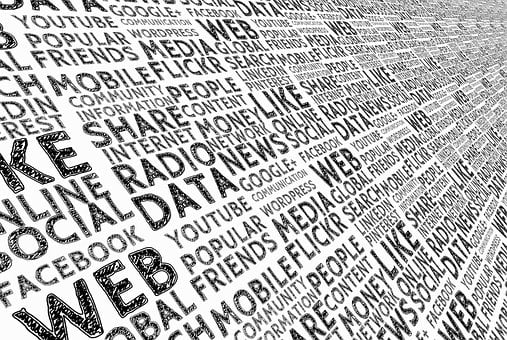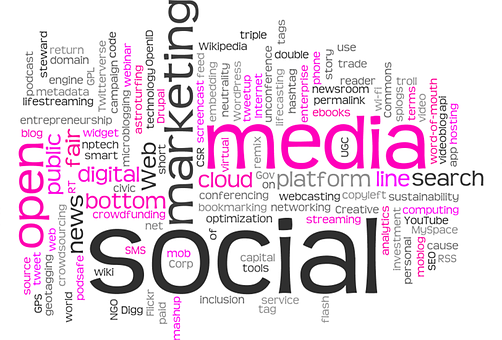Social media designers craft high-quality graphic content and posts it on all the company’s social media profiles. Their job is to employ their graphic design and programming skills to create compelling posts, pages, and applications that drive traffic and boost conversions.
They also need to possess extensive marketing knowledge to be able to come up with the most appropriate content for a specific target audience.

What Does a Social Media Designer Usually Do?
1. Develop new concepts
2. Designing top-notch visual content
3. Test graphics on different devices
4. Improve marketing efforts
5. Strengthen the brand image
Developing New Social Media Graphics Concepts
Social media designers develops fresh concepts for creating graphic content in line with the company’s goals. They need to track developments of various social trends and patterns and determine the best solutions for crafting relevant and valuable posts for different social media channels.

A Social Media Designer needs to determine the best way to present those concepts to a target audience, with the goal to convert followers into customers.
Designing Top-Notch Visual Content
Designing and implementing high-quality graphic content is one of the main priorities of a Social Media Designer. This includes a variety of visual content types, such as:
- High-quality and attention-grabbing images that grab the users’ attention and improve the brand’s credibility
- Visually compelling infographics that present valuable information about your company in a compelling way
- Quote graphics that reflect the vision and message of your brand, enabling followers to relate and build a relationship with your business
- Customer testimonials that present your company’s success in a way that builds trust and drives followers to convert
- Logos and fonts that maintain brand consistency and professionalism
Testing Graphics on Different Devices
An essential part of the Social Media Designer’s job is to ensure that all the graphic elements that they create are presented on different devices flawlessly. This includes providing the best possible user experience for the large chunk of your audience that consists of mobile users.

Improving Marketing Efforts
A Social Media Designer works closely with the marketing department to create a strong social media presence. This includes designing top-notch content for ads, banners, product pages, etc.
It’s crucial for a Social Media Designer to be up to date with current marketing trends so that they can create adequate visual content that generates conversions and sales. They also need to be well acquainted with the newest SEO practices to ensure that the content is shown by search engines prominently.
Strengthening the Brand Image
A Social Media Manager creates and manages the overall look and feel of various types of content that the company posts on its social media profiles. Their job is to ensure that all the marketing materials have a consistent design and message.
By maintaining visual consistency, Social Media Managers boost the brand image, loyalty, and recognition.

Roles a Social Media Designer Typically Collaborates With
Based on the structure of your business, a Social Media Designer will collaborate with different crucial roles. Some of those positions are:
Social Media Designer Salary
In the United States, a Social Media Designer earns an annual salary of approximately $48,000.
Based on their set of skills and level of experience, the salary of a Social Media Designer ranges from $34,000 to $66,000.

Social Media Designer Job Description Template
We at [Company Name] are looking for a talented Social Media Designer with excellent attention to detail. They will be responsible for designing original content on all our social media channels, including [list relevant social media platforms].
As a Social Media Designer at [Company], you will create high-quality graphic materials that will boost our brand image and help us build a loyal customer base. Your job will also be to work with our programmers on developing attention-grabbing apps for boosting engagement and increasing conversions.

As a Social Media Designer, you need to be exceptionally creative and motivated. This position requires extensive marketing knowledge and comprehension of social media trends. You need to have great communication and organizational skills, and be able to both come to decisions independently and work in a team environment.
Social Media Designer Responsibilities
- Design top-notch graphic content for different social media channels
- Develop fresh concepts based on company goals and current social media trends
- Analyze design briefs and outline requirements
- Present ideas and drafts to the team
- Ensure that all the graphic elements are consistent in terms of style, colors, and message
- Test graphic elements on different devices
- Utilize programming skills to create engaging apps and build exceptional pages
- Work with the marketing team to build a strong social media presence
- Measure key performance indicators and provide suggestions on what can be improved
What Is the Social Media Designer Pay Difference by Experience?
The Social Media Designer pay varies in line with their level of experience.

Roles a Social Media Designer Typically Collaborates With
Based on the structure of your business, a Social Media Designer will collaborate with different crucial roles.
These days, consumers are bombarded by Tweets, Facebook Posts, texts and messages on their computers and mobile devices. When users only spend seconds viewing these messages, social media graphics that accompany them are vital in building brand awareness and recognition and attracting the user’s attention.
Definition of Social Media Design
Social media design is visual content used in digital marketing. Whether it’s your Facebook profile, Twitter background, Google+ header or graphics for timeline posts and blogs, social media design is an important element to incorporate.

Did you know…our brains process visuals about 60,000 times faster than text. It turns out that an image is worth more than a thousand words.
How Can Social Media Design Help Your Brand?
Consumers respond best to a first impression that includes a visually appealing attention-grabbing graphic image. When graphics are used consistently across your different social media platforms it creates brand recognition. Also, many people are visual learners, so they are likely to remember your brand better when they see it visually, instead of hearing or reading about it.

Your graphic design and company logo play a big role in how your product or service is perceived. Using attractive graphics helps to strengthen your brand and build trust with the consumer. A well-designed graphic can also stir the user to share your posts on his or her own social media pages; which extends the reach of the post.
What are the Benefits of Social Media Design?
· Creates more brand recognition
· Builds brand awareness
· Attracting user’s attention
Social Media Design Tips
Tip 1: Use High-Quality Photography
The images you use on social media are a reflection of your brand, so invest in quality images. A good stock image not only grabs you consumers’ attention, but it can also boost your brand’s credibility and professionalism.

Tip 2: Use a Variety of Visual Content
Quote graphics help your fans connect with the meaning and message of your brand – not just your product.
- Storytelling is one of the most compelling ways to engage your audience with your brand, and infographics allow you to do this in a visually captivating way.
- Customer testimonials build customer trust, create goodwill for your product, and shows potential customers a positive brand history.
- Show off your Team – Images of employees having a little fun or working hard can help customers relate to a company on a more personal level.
Tip 3: Brand Your Graphics
The goal of creating highly shareable social media graphics is to drive people back to your website. By adding your logo or company URL to your social media images, it helps users find you if they want more information.

Tip 4: Keep Fonts & Colors Consistent
Choosing a consistent font palette is a fantastic way to ensure consistency and to build familiarity with your customers. Stay consistent with your color choices that reflect your ‘brand personality’.

Tip 5: Choose The Right Size
Using the correct size ensures that people see what you w
The complete guide to social media design
In the past, you could have easily described Facebook as an industry-changing fad. Nowadays, establishing a website is as vital as establishing a telephone number, and it also helps you ensure that followers are responding. Facebook and Twitter are great places for businesses to contact the real people in your industry that support them. In this place, create links through content to engage your fans and increase brand awareness. Social networks can be useful, but are also competitive.

Before you start your social media design
Plan your social media design strategy
The first step in social media design is to create your strategy (or review your existing one). Design should act as an enhancement to your content, facilitating the messages you want to get across, so it’s essential to first create a solid messaging strategy in order to perform well.
1. Evaluate the audiences for your current channels. You may already have already conducted target audience research for your overall brand strategy, but the audience for each social media channel will represent a specific segment or cross-section of your larger audience. In order to create the most effective social media design, understand who is currently following your content and what they are looking for.

2. Choose the best platforms to reach your audiences. Social media is necessary for businesses, but that doesn’t mean every social media platform is necessary for every business. For example, recipes perform notoriously well on Pinterest, so while it makes sense for a food brand to invest heavily in that platform, it won’t be as important for, say, a home security brand. Research your many options for social media platforms, and decide on a few based on what is popular within your industry and with your audience. Assuming that you should only use the most popular platforms may lead you to miss out on social media apps with niche audiences that might be perfect for your brand.
3. Evaluate the types of content that perform best on those platforms. Narrowing the scope of your audience and social media channels will allow you to focus on the kinds of content to create and eventually how that content should be designed. Some of the types of content you can create will be set by the platform (Instagram favors imagery and video, Twitter favors short messages and clips). Each platform should have a how-it-works page that will explain the media constraints. Other types of content will be based on common user trends: although people have the ability to create videos and written messages on Facebook, many users use the platform to share article links. Spend some time reviewing user activity, paying close attention to your competitors, to get an idea of how to best use each channel.
List, brief and schedule your design assets
Now that you have a better idea of your audience and the channels you’ll be using, you can start mapping out a design pipeline with a series of briefs. This, along with a content calendar, will help keep you organized through the design process. Make sure to document the following:
- Upcoming content plans
- The goal of the content
- Intended audience
- Competitor content examples
- Design medium (photograph, video, illustration, animated gif)
- Caption or text copy
- Design references
Tips on designing your social media profile page
Now that you have a strategy in place, you’re ready to set up your social media profiles for success. Your profile is the homepage to your social media account. It is where users will go when they search your name or are otherwise directed via a link. It is also where the “Follow” button will live—a well-executed profile design can make the difference in whether or not they click it.

The goal of your profile page is to tell prospective followers who you are. While your bio should lay this out in a few concise statements, the design of your profile will do so visually, using color, shape and imagery to express your brand identity.
Profile picture design
Your profile picture (or avatar) is, along with your handle, your online identity. It is the part of your profile that will be seen outside of your profile page, acting as a signature for your posts. This is why profile pictures are generally small, to give more attention to your actual posts. With that in mind, focus your avatar on simplicity.
Some brands can get away with using their entire logo if it’s legible at a tiny size. Many brands will instead opt for an abbreviated version (either the first letter in the brand name or the logomark by itself). Backing this version of the logo with a bold color or pattern can help it stand out. Also keep in mind that although dimensions are given in a square orientation, most platforms use circular avatars.

FAQs: Unlocking Insights
Uncover answers to common questions about Social Media Designer.
What qualifications do Social Media Designers typically have?
Social Media Designers often possess a degree in graphic design, digital media, or a related field. However, a robust portfolio showcasing creativity and proficiency in design tools can be equally valuable.
How do Social Media Designers stay inspired?
Social Media Designers draw inspiration from diverse sources, including other designers, nature, and current design trends. Constant exposure to new ideas fuels their creativity.
Is coding knowledge essential for Social Media Designers?
While not mandatory, a basic understanding of coding languages can be advantageous for Social Media Designers, especially when collaborating with web developers.
How important is user feedback in the design process?
User feedback is invaluable for Social Media Designers. It helps them refine their designs, understand user preferences, and create content that resonates with the target audience.
What software do Social Media Designers commonly use?
Popular design tools among Social Media Designers include Adobe Creative Suite, Canva, and Figma. The choice often depends on individual preferences and project requirements.
How can aspiring designers build a strong online presence?
Building a strong online presence involves showcasing a diverse portfolio, engaging with the design community on social media, and staying active on platforms like Behance and Dribbble.
Conclusion
Embark on your journey to understanding the world of Social Media Designers. From the fusion of creativity and strategy to the intricacies of platform-specific design, this guide equips you with the knowledge to navigate the dynamic landscape of digital design. Embrace the power of visual storytelling and unleash your creativity in the ever-evolving realm of social media.


